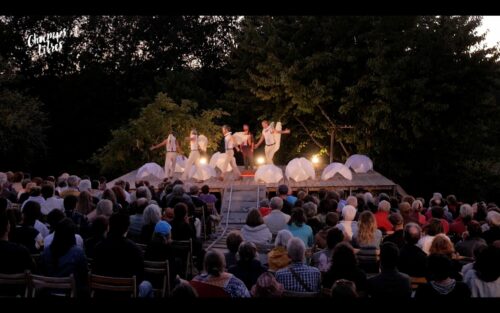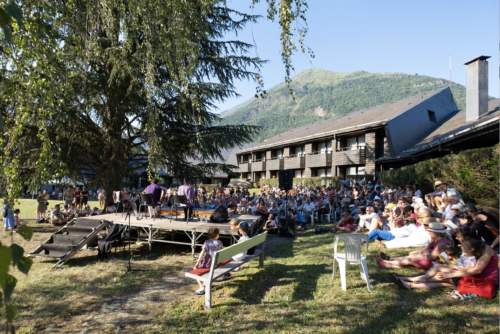Faisant écho au dernier rapport du Syndeac, le livre 20 000 mots récemment publié par le percussionniste Sylvain Darrifourcq est une passionnante réflexion sur la question du travail – et de la « productivité » – artistique dans le « monde d’après » et sur les rapports de force qui régissent le milieu culturel.
Dans les pays anglo-saxons, il existe un terme, « Community art », désignant les pratiques d’artistes installés sur un territoire et œuvrant pour et avec les habitants de celui-ci. Il s’agit d’un mouvement artistique à part entière, né en Grande-Bretagne dans les années 1960, qui peut trouver ses racines dans la notion de « sculpture sociale » développée par Joseph Beuys, et qui recoupe par certains aspects l’esthétique « relationnelle » théorisée par Nicolas Bourriaud ou l’art « contextuel » de Paul Ardenne. Un mouvement dont les réalisations, généralement participatives, à tout le moins collectives, tranchent singulièrement avec la conception encore communément admise – largement empreinte de romantisme, et finalement très surplombante – de l’Œuvre d’art. Un mouvement dont l’ambition est ainsi doublement politique, puisqu’il s’agit à la fois de lutter contre les reproches d’élitisme adressés – parfois légitimement – au milieu de l’art et de faire, ensemble, œuvre culturelle plutôt que simplement artistique, en floutant notamment la frontière entre amateurs et professionnels.
J’ai découvert tardivement cette notion – cet automne, à la faveur d’un séminaire de recherche-action sur la Convention de Faro (convention-cadre « sur la valeur du patrimoine culturel ») organisé conjointement, à Bordeaux, par le Conseil de l’Europe, la Région Nouvelle-Aquitaine et la Ville de Bordeaux, auquel participait justement un community artist britannique, Ed Carroll. Et je me suis aussitôt demandé pourquoi je n’en avais pas entendu parler plus tôt, pourquoi cette notion n’existait pas en France. Cela est sans doute lié à la méfiance et aux connotations négatives qui, chez nous, entourent le terme de « communauté », auquel on a automatiquement tendance à rattacher celui de communautarisme. Pourtant, si l’on songe aux « communes » du Moyen Âge ou aux « communs » d’aujourd’hui, voilà un terme au moins aussi fécond que celui de « société » pour penser un mode d’organisation et d’action collectives. Du festival Chahuts à Bordeaux à celui de Villeréal dans le Lot-et-Garonne ou aux Nuits d’été initiées dans l’avant-pays savoyard par le Quatuor Béla, sans parler des artistes de toutes disciplines qui, de plus en plus nombreux, s’établissent sur un territoire – généralement rural – pour y partager leur pratique avec les personnes qui y vivent, on pourrait citer bien des exemples de « community art » à la française, d’initiatives visant à faire de l’art, en actes et non plus simplement en discours, un vecteur de transformation sociale. On serait néanmoins bien en peine de traduire cette notion autrement qu’en convoquant des termes – « pratiques socio-culturelles », « formes participatives » – encore largement dépréciatifs dans la sémantique institutionnelle en vigueur.


J’y ai repensé, à cette notion, encore plus récemment, à la lecture du rapport publié en mars dernier par le Syndeac (Syndicat des entreprises artistiques et culturelles) sous le titre : « La mutation écologique du spectacle vivant : des défis, une volonté ». Un rapport qui venait prolonger celui publié un an plus tôt, « Pour un service public de l’art et de la culture », formulant « 13 propositions pour un New Deal culturel », et formalisant notamment la notion de « projet situé » pour désigner, précisément, des actions culturelles pouvant s’apparenter au « Community art ». Deux documents passionnant, prenant acte d’un besoin de transformation radicale de la politique culturelle.
Le rapport de 2023 met en particulier l’accent sur la « surproduction » de spectacles – à un moment où en outre, les artistes n’ont sans doute, proportionnellement, jamais été aussi nombreux dans la société – , et sur les limites d’un système fondé sur la nouveauté à tout prix et sur la règle du « toujours plus » : un phénomène perceptible depuis bien longtemps, mais auquel la pandémie du Covid-21 n’a fait que souligner l’urgence de remédier : « “Toujours plus” de créations voient le jour chaque année dans de mauvaises conditions de production et sans possibilité d’être véritablement diffusées, “toujours plus” de spectacles souffrent ainsi de n’être que très peu montrés, “toujours plus” d’équipes artistiques vivent sous la contrainte de la nouvelle création comme seul moteur de l’emploi et donc de la survie économique. » Face à cela, le Syndeac invite à dépasser le sacro-saint binôme « création / diffusion » – aussi épuisant pour les artistes que pour les programmateurs – comme unique prisme d’évaluation : pour que le ministère de la Culture soit davantage qu’un « ministère des Arts » (formulation figurant dans le rapport de 2022 – mieux vaut tard que jamais), il nous faut « arrêter de centrer nos réflexions au prisme du nombre de représentations. Une équipe artistique existe aussi en dehors de ses spectacles. Sa présence sur un territoire, qui s’incarne par des temps de résidences et des temps d’action culturelle, doit être valorisée. » En dehors des temples dédiés à la diffusion des œuvres, il y a d’autres manières de faire culture ensemble, de manière plus locale, plus « située », plus modeste peut-être, mais certainement plus efficace en terme de ce que l’on appelait jadis la « démocratisation culturelle ».
On le voit, c’est à un véritable changement de paradigme qu’invite le rapport du Syndeac. Après Malraux, après Lang, le temps est venu d’écrire l’acte III d’une politique culturelle qui ne raisonne pas qu’en termes d’offre artistique. Le rapport du Syndeac propose de réfléchir à une « autorégulation » qui permette de produire moins, mais mieux. Tout en rappelant son attachement au régime de l’intermittence, il appelle également repenser en profondeur la valorisation des métiers artistiques afin de prévenir la paupérisation d’équipe artistiques toujours plus nombreuses – citant à l’appui un extrait d’un passionnant ouvrage d’Aurélien Catin, membre de l’association d’éducation populaire Réseau Salariat, sur la condition des artistes-auteur.e.s, Notre condition, Essai sur le salaire au travail artistique : « L’ensemble de nos activités dérivées et de nos “prestations de services” [notons que ce terme est symptomatique de la manière dont est pensée par certaines collectivités la valeur de notre travail artistique sur un territoire] ne sont pas du bonus […] mais des travaux productifs qu’il convient de rémunérer en tant que tels ».


Cette question de la condition des artistes – et des musiciens en particulier – et des « mutations nécessaires d’un monde de la culture en déséquilibre » est précisément au cœur d’une autre publication récente : 20 000 mots, long entretien entre le percussionniste Sylvain Darrifourcq et Antoine Lebousse. La lecture de ce livre est d’abord passionnante par la manière dont Darrifourcq expose, avec beaucoup de clarté, de lucidité et d’humilité, son parcours, sa vision de sa pratique et de la condition de musicien improvisateur en 2023, au sortir d’un confinement qui lui a donné le temps de se questionner en profondeur sur celles-ci : « Pourquoi avons-nous construit nos carrières, à l’image de notre société, autour de cette idée de production de services, de biens, de sens et aussi, souvent, de vide ? Pourquoi la productivité est-elle la valeur étalon de la santé de notre société ? Ces questions m’ont amené à repenser ma carrière, ma façon d’être dans mon milieu, la façon d’être artiste dans la société, et plus généralement ma façon d’être dans la société. »
Cette lecture est, surtout absolument stimulante par sa manière, là encore d’une grande lucidité, de démonter les rouages qui organisent le système culturel français contemporain, et de pointer les contradictions inhérentes à celui-ci : refusant de parler de « culture sacrifiée » durant le confinement, il préfère souligner combien la pandémie aurait pu être l’occasion de réfléchir à la « véritable disproportion entre les aides à la création de spectacles, qui sont nombreuses, et l’organisation du réseau des salles qui ne permet pas une diffusion satisfaisante » – ce déséquilibre entre production et diffusion que pointe justement le rapport du Syndeac. Et exprimer son « immense fatigue face à ce fonctionnement qui nous chosifie, nous comprime dans une course à la productivité de plus en plus rude, dans un système hyperconcurrentiel dont les règles semblent particulièrement floues. (…) J’ai l’impression que cette parole n’a pas été entendue, qu’elle a été “étouffée” par les revendications plus bruyantes d’une partie de la profession qui se désolait du “peu de cas” que le gouvernement accordait au monde du spectacle vivant, et qui appelait au retour de la culture “sacrifiée”. Ce discours, sous couvert de bonnes intentions, partait du principe que les artistes avaient tous un désir irrépressible de repartir sur scène comme avant, aussi vite que possible. Et je suis bien placé pour savoir que c’est loin d’être le cas. »
Ce faisant, Darrifourcq se rapproche d’Aurélien Catin par sa manière de poser, en filigrane, la question de l’engagement des artistes. Et des manières de restaurer le lien, essentiel mais ô combien fragile, entre l’art et la communauté.
David Sanson
Photo Festival Villeréal © Champs libres
Photo Jazz à Luz © Y François AE Médias
Photo Chahuts © Pierre Planchenault



)